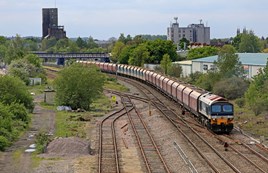The amount of freight carried on the national rail network is at its lowest since the time of the miners’ strike of 1984-85.
Office of Rail and Road (ORR) statistics reveal that the total amount of freight lifted fell from 110.5 million tonnes in 2014-15 to 86.0m tonnes in 2015-16 - a drop of 22.2%. The amount of coal lifted in 2015-16 was 19.8 million tonnes - a decline of 54.6% from the corresponding period in 2014-15, and also the lowest since 1984-85.
ORR states that the amount of freight lifted reached its peak in 1988-89, when 149.5 million tonnes were carried. The lowest was 65.2 million in 1984-85 (corresponding with the 12-month miners’ strike), when 14.5 million tonnes of coal was lifted.
Rail Freight Group Executive Director Maggie Simpson said: “These results confirm that 2015-16 has been a very difficult year for rail freight. The focus now has to be in turning the sector back to growth, and resuming the positive successes of recent decades.”
- For much more on this, read RAIL 803, published today (June 8).















Comment as guest
Comments
Richard Pill - 10/06/2016 15:26
To be honest we've had so many writing off freight by rail except for block loads for so many years that after Speedlink went, not a lot has replaced it. We need to see that units break down to small loads and small loads build upwards to provide diverse train-loads. These may be varied consignments but a Speedlink style system is needed to cohere these flows into the paths available. Clearly more capacity is needed but the contrast is Hs2 and branch lines in Nottinghamshire getting a look in, contrast Bedford-Northampton and integrations thereof being dismissed as fanciful. By faith one moves mountains, by collectives cooperating could we see the 3 R's informing more freight by rail: Renewables, Recycling and Rails for them to go on off of busy main lines.
Reply as guest
FrankH - 29/06/2016 00:33
The profit margins are minimal for block type freight loads. Pick up type trains would cost more than by road and also a lot of goods yards and sidings that cou;ld have been used have been lifted adding more cost to it. Paths for freight are scarce now because of their lower speed, a stopper blocking lines would have little chance of getting a path. Look at the freight depot at Telford, brand new facility, track everything. Didn't get the projected business and has now been quietly forgotten about. Last use was storing EMU's I think. As much as I would like your idea to suceed the days of the small rural depots have gone and it's the same with the road haulage also.
Reply as guest
FrankH - 29/06/2016 00:10
"The amount of freight carried on the national rail network is at its lowest since the time of the miners’ strike of 1984-85". By a coincidence there isn't a pit mining coal in England any more, an even less coal to be carried might be the reason.
Reply as guest
Richard Pill - 29/06/2016 07:17
Your comments are intrinsically interesting and may well reflect the situation as it is now. Key question surely though is do we accept this diminished situation or do we seek to challenge it with a 'start again' attitude. Again, road-air only guzzles fossil fuel and pollution takes a toll as well as congestion. Can we really consign diminished rail share and freight to history, without needing to override the status quo for a better environmentally sound future? Sure, I may be cornered like Jeremy Corbyn as a leftie idealist, but the current situation is hardly a dream ticket and cost has to be weighed in the round, collectives can do more than isolated units. I seek to ignite that, whilst recognising the rail fraternity can be most conservative for any change.
Reply as guest
FrankH - 29/06/2016 10:33
"road-air only guzzles fossil fuel " as does rail in the majority of cases with less environmentally friendly engines than road. Euro 3b vs the latest Euro 6 for trucks. Rail freight is only better for the environment when (I'm guessing here) 13 or more units (wagons) are in tow. Any less and pollution would be more than road. Pick up freight would cause even more pollution because of it's stop start nature, Smaller older engines (there arn't many left) more suited to pick up work cause even more pollution. Some have been converted recently, cost I've no idea £500,000 maybe, these were for specific passenger use which is subsidised heavily. Your average modern diesel freight loco is 3300 hp, not the sort for pick up work. Electric traction for freight is maybe 70 locos (not all in use by the way) in total the youngest being 20-30 years old, eldest 50 and still in daily use. Operators will not buy new locos until they can run end to end under the wires, now this is about to change. New dual power locos 5400 hp ish electric plus 950 hp diesel engine for the last mile where no wires exist. Only 10 but I can see more being ordered once these prove their worth. These will save 1000's of gallons of fuel a day on the WCML where diesels run under the wires for hundreds of miles a time.
Reply as guest